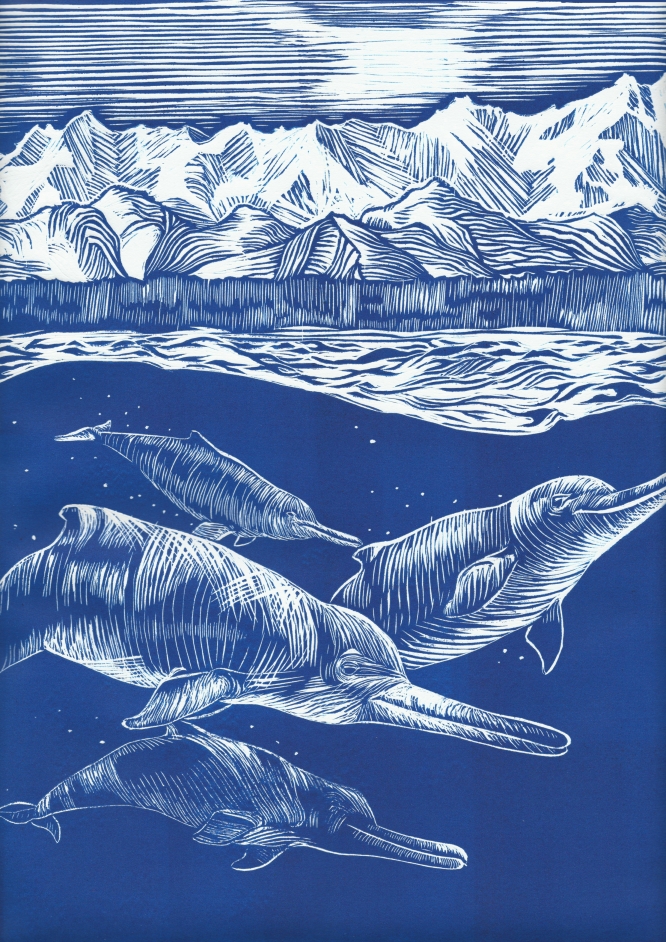- The fossil, an incomplete skull about nine inches long, was discovered by geologist Donald J Miller in 1951 in Alaska.
- For the next six decades, the skull remained in Smithsonian’s collection, until researchers decided to examine it.
- The researchers have found that the dolphin skull is among the oldest fossils from Platanistoidea, a group that once included a large, diverse family of marine mammals, but is now represented by a single freshwater river species, the South Asian river dolphin Platanista gangetica.
Scientists have identified a new species of prehistoric dolphin from a fossil that lay undescribed in the collection of the Smithsonian’s National Museum of Natural History for the last 65 years.
Researchers have named the dolphin Arktocara yakataga. The word Arktocara is derived from Greek and Latin words meaning “the face of the north”, according to a study published in PeerJ, while yakataga is the indigenous Tlingit people’s name for the region where the fossil was found.
“We are always learning new things about the vast legacy built by our predecessors at the museum,” co-author Nicholas D. Pyenson, curator of fossil marine mammals at the Smithsonian, said in a statement.
The fossil, an incomplete skull about nine inches long, was discovered by geologist Donald J Miller in 1951 while he was mapping the Yakataga region of Alaska between 1944 and 1963. For the next several decades, the skull remained in Smithsonian’s collection, until Pyenson, and Alexandra Boersma, a researcher in his lab, decided to take a closer look at it.

Pyenson and Boersma compared the skull with those of other dolphins, and found that the ancient dolphin species most likely swam in the cold subarctic waters some 25 million years ago. The endangered South Asian river dolphin, a species that lives in the tropics, may be its only living relative today, the researchers say.
“Considering the only living dolphin in this group is restricted to freshwater systems in Southeast Asia, to find a relative that was all the way up in Alaska 25 million years ago was kind of mind-boggling,” Boersma said in the statement.

The researchers also found that the dolphin skull is among the oldest fossils from Platanistoidea, a group that was once represented by a large family of marine mammals, but is now represented by a single freshwater river species, the South Asian river dolphin Platanista gangetica.
The Arktocara fossil is the northernmost of all the fossils of Platanista’s now extinct relatives that have been found around the world to date, the researchers say.
The species Platanista gangetica includes both the Ganges river dolphin and the Indus river dolphin found in India, Nepal, Bangladesh and Pakistan. Both subspecies, currently listed as Endangered on the IUCN Red List, are threatened by habitat destruction, pollution, entanglement in fishing nets and other human activities. Only a few thousand individuals remain today.
These dolphins are blind, use echolocation to catch prey in murky river waters, and swim on their sides. They are also difficult to study, scientists say, mainly because of their declining numbers.
“One of the most useful ways we can study Platanista is by studying its evolutionary history, by looking at fossils that are related to it to try to get a better sense of where it’s coming from,” Boersma said. “Exactly how that once diverse and globally widespread group dwindled down to a single species in Southeast Asia is still somewhat a mystery, but every little piece that we can slot into the story helps.”
CITATION:
- (2016) Arktocara yakataga, a new fossil odontocete (Mammalia, Cetacea) from the Oligocene of Alaska and the antiquity of Platanistoidea. PeerJ 4:e2321 https://doi.org/10.7717/peerj.2321